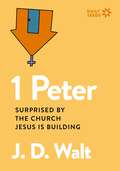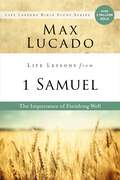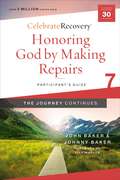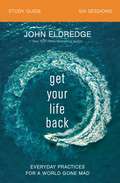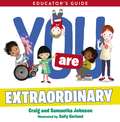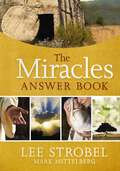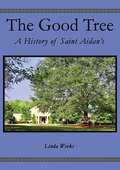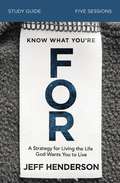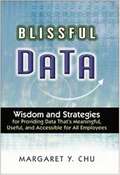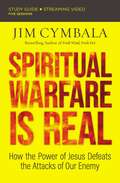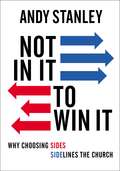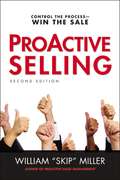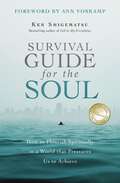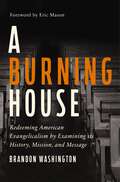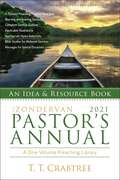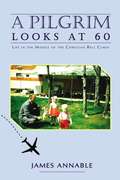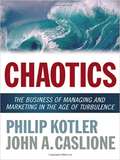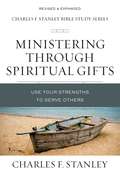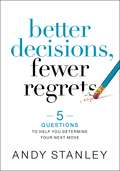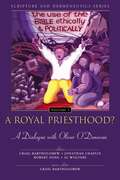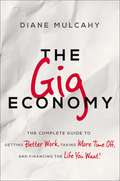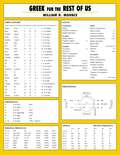- Table View
- List View
1 Peter: Surprised by the Church Jesus is Building (Daily Seeds)
by J.D. WaltThis book helps followers of Jesus see themselves as Jesus sees them--people indwelled with his Spirit being built up to impact the world. You will move beyond education and knowing things about Jesus to spiritual awakening and transformation through daily immersion in Scripture. J. D. encourages reading the Bible with others and to put spiritual insights into action.Daily Seeds 1 Peter includes:48 daily readings from 1 PeterSubstantive insights from 1 Peter and a deeper reflection on its meaningPrayers to deepen the influence of Scripture in your lifeQuestions that encourage action in the world1 Peter can be used for personal study and in small groups. Meeting weekly with a group is highly recommended to share insights and to encourage one another for greater spiritual impact in the world.
Life Lessons from 1 Samuel: The Importance of Finishing Well (Life Lessons)
by Max LucadoIt matters how you finish.A good start is crucial, but it's the end that matters. First Samuel is a book of good starts but bad finishes. Eli was a sterling religious leader, but by the end of his life, the ark of the covenant had been captured and his two rebellious sons killed. Samuel was a prophet of God who anointed kings, but his sons also turned away from the Lord. The most dramatic example is Saul. He seemed to be the perfect choice for Israel's first king. But success led to disobedience, and he slid from prominence to paranoia to suicide. These stories remind us that when it comes to our faith, we also need to finish well. As the apostle Paul wrote, we must "run in such a way as to get the prize" (1 Corinthians 9:24).The Life Lessons with Max Lucado series brings the Bible to life in twelve lessons filled with intriguing questions, inspirational stories, and poignant reflections to take you deeper into God's Word. Each lesson includes an opening reflection, background information, an excerpt of the text (from the New International and New King James versions), exploration questions, inspirational thoughts from Max, and a closing takeaway for further reflection. The Life Lessons series is ideal for use in both a small-group setting and for individual study.
Honoring God by Making Repairs: A Recovery Program Based on Eight Principles from the Beatitudes (Celebrate Recovery)
by John Baker Johnny BakerCelebrate Recovery introduces The Journey Continues—four new participant's guides designed as a revolutionary, new second step study curriculum. This step study is taken after completing The Journey Begins (Participant Guides 1-4). In the seven lessons in Guide 7: Honoring God by Making Repairs, you will experience Christ-centered and biblically based studies filled with brand new acrostics, deeper questions, and more helpful Bible verses. The content in Guide 7 will focus on a deeper study of principles 4-6 of the recovery process:Openly examine and confess my faults to God, to myself, and to someone I trust. "Happy are the pure in heart" (Matthew 5:8).Voluntarily submit to every change God wants to make in my life and humbly ask Him to remove my character defects. "Happy are those whose greatest desire is to do what God requires" (Matthew 5:6).Evaluate all my relationships. Offer forgiveness to those who have hurt me and make amends for harm I've done to others, except when to do so would harm them or others. "Happy are the merciful" (Matthew 5:7). "Happy are the peacemakers" (Matthew 5:9).By working through the lessons and exercises found in each of the four participant's guides of The Journey Continues you will find a deeper sense of true peace and serenity, continue to restore and develop stronger relationships with others and with God, and find deeper freedom from life's hurts, hang-ups, and habits.
Get Your Life Back Study Guide: Everyday Practices for a World Gone Mad
by John EldredgeYou don't need to abandon your life to get it back. You can restore it with sustainable practices that are within your reach. And you will never be the same...We live in soul-scorching times. The 24-7 onslaught of contemporary life—with its never-ending feed of global tragedies, demands for our attention, and pressures of work, family, and friends—has left us feeling ragged, wrung-out, and emptied. But if we have no margin in our lives, how do we find room to change anything?In this life-changing video Bible study (DVD/digital downloads sold separately), John Eldredge distills a lifetime of wisdom into five practical and ready-to-implement practices for putting your life back together:The one-minute pause,Benevolent detachment,Practicing kindness,Getting outside, andStepping back from technology.Together, these simple practices will add up to enable you to begin recovery, care for the neglected places in your soul, and rediscover the hidden life of God in you.Rest assured, the graces offered in this study are within reach of normal life. They're practicable and refreshing. God wants to come to us and restore our lives. We just need to put ourselves in places that allow us to receive his help. Designed for use with Get Your Life Back Video Study (sold separately).
You Are Extraordinary Educator's Guide: Educator's Guide
by Craig Johnson Samantha JohnsonYou Are Extraordinary Educator's Guide is a companion to You Are Extraordinary by Craig and Samantha Johnson. This guide can be utilized in the classroom, in a home school setting, or by parents seeking additional resources. Ideal for Kindergarten through 1st grade.
The Miracles Answer Book: Seeing God Work in Divine Ways (Answer Book Series)
by Lee Strobel Mark MittelbergIs God still in the miracle business today?This is the question Lee Strobel asked himself. A former atheist turned Christian, Lee launched a two-year investigation into the supernatural. The results will amaze you and strengthen your faith as you discover surprising truths. Using the popular question-and-answer format, Lee will lead you on a voyage of discovery and discernment as he takes on tough questions such as:Can you explain the difference between a divine miracle and an ordinary coincidence?Aren&’t there a lot of fake miracles?Haven&’t studies proven that prayer doesn&’t make any difference?Why is it important to know God acted in history? It&’s so you&’ll know He is able to continue to work today—in our world and in your life. The Miracles Answer Book will provide you with a more profound sense of the lengths that God will go to strengthen the faith of His people.
The Good Tree: A History of Saint Aidan’s
by Linda WeeksIt was a project like no other. There was an energy right from the first meeting. Not everyone knew each other but it didn&’t matter. No-one knew how to do this thing but that didn&’t matter either.In 1993, the Right Reverend Frank K. Allan, 8th Bishop of the Episcopal Diocese of Atlanta, was keeping an interested eye on the rapid development of a northern suburb known as Johns Creek. He began to think about the Christian souls who were settling there, putting down roots to begin a new life and raise their children in a new city. Where would they worship? How would they express their Christian faith? What could he do meet their needs?The Good Tree is the story of a group of parishioners from Saint David&’s Episcopal Church in Roswell who got together to build a mission church in nearby Alpharetta. Beginning with prayer and enthusiasm and guided by the inspirational Father Noel Burtenshaw, the founding of a new mission church was a deeply spiritual and yet very human journey for all concerned. The Good Tree describes that journey, from its unexpected beginnings, through the first twenty-five years of highs and lows, twists and turns, including the difficult period that followed the ordination of Canon Gene Robinson as Bishop of New Hampshire.If you ever wondered how a church building comes to be in a particular place at a particular time, or if you are interested in exploring the expression of Christianity in the modern world, or if you are simply interested in reading an inspiring story about a group of ordinary people with a determined Christian purpose, then you will enjoy reading The Good Tree.
How to Read the Old Testament Book by Book: A Guided Tour
by Douglas Stuart Gordon D. FeeReading the Old Testament doesn't need to be a difficult journey through strange and bewildering territory. How to Read the Old Testament Book by Book walks you through the Scriptures like an experienced tour guide, helping you understand each of its thirty-nine books.For each book of the Old Testament, the authors start with a quick snapshot, then expand the view to help you better understand its message and how it fits into the grand narrative of the Bible. Written by two top evangelical scholars, this survey is designed to get you actually reading the Bible knowledgeably and understanding it accurately.In an engaging, conversational style, Gordon Fee and Douglas Stuart take you through every book of the Old Testament using their unique approach:Orienting Data - Concise info bytes that form a thumbnail of the book.Overview - A brief panorama that introduces key concepts and themes and important landmarks in the book.Specific Advice for Reading - Pointers for accurately understanding the details and message of the book in context with the circumstances surrounding its writing.A Walk Through - The actual section-by-section tour that helps you see both the larger landscape of the book and how its various parts work together to form the whole.How to Read the Old Testament Book by Book can be used as a companion to How to Read the New Testament Book by Book and How to Read the Bible for All Its Worth. It also stands on its own as a reliable guide to reading and understanding the Old Testament for yourself.
Know What You're FOR Bible Study Guide: A Strategy for Living the Life God Wants You to Live
by Jeff HendersonDo the people in your world know you&’re FOR them?In our world today, people are often known more for what they are against than what they are for. Unfortunately, this extends even into the church. We want to reach the lost with the incredible good news of Christ, but often all they ever hear us emphasize are the behaviors and attitudes we are against.In this video Bible study (DVD/digital videos sold separately), pastor Jeff Henderson points out God is FOR the people in our world. He is FOR breaking down unnecessary barriers that keep people away from experiencing his love. And as his followers, he calls us to be spouses, parents, friends, leaders, and employees who do the same.The Know What You&’re FOR Study Guide includes video teaching notes, discussion questions, and weekly personal study and reflection questions.Sessions include:What Are You FOR?FOR Your WorldFOR Your TeamFOR Your CommunityFOR Your LifeDesigned for use with Know What You&’re FOR Video Study (9780310119654); sold separately. Streaming video also available.
Blissful Data: Wisdom And Strategies For Providing Meaningful, Useful, And Accessible Data For All Employees
by Margaret Y. ChuAnalyzing information and acting accordingly is a key strategic goal of every business. But vast quantities of data are of little use if they are not structured and kept in such a way as to be readily accessible and applicable. Only optimally organized information can drive maximum productivity. Blissful Data is a reader-friendly book that reveals what it takes to achieve a state of perfect organization within the environment of a successful data warehouse. This timely book will help the reader: * understand how data evolves into information that drives better decision making * recognize the pitfalls, caused by people and politics, that lead to short-sighted solutions and long-term problems * manage data warehousing costs, performance, and expectations effectively * apply project management fundamentals to data warehouse endeavors. Blissful Data includes dozens of examples, as well as case studies illustrating successful, unsuccessful, and disastrous data warehouse strategies.
Spiritual Warfare Is Real Bible Study Guide plus Streaming Video: How the Power of Jesus Defeats the Attacks of Our Enemy
by Jim CymbalaSatan is not out to get you to follow him; he's out to get you to ignore him. When we spiritually zone out, doze off, fall asleep, we are forgetting that we are in the middle of a war--and Satan loves it this way! He loves to convince people he doesn't exist. But Satan is real. He is an actual enemy of our soul. He is waging a real war against us. And we need to wake up and get in the fight. If we fail to do this, we do so at our own peril.In this five-session video Bible study (streaming included), bestselling author Jim Cymbala shows participants how to:Recognize the spiritual wars around them.Understand the enemy's plots against them.Develop practical strategies for fighting back.As believers in Christ, we have been given everything we need to stand strong and take the fight to the enemy. As we do, we will recognize, as the apostle Paul writes in 1 Corinthians, that God "gives us the victory through our Lord Jesus Christ" (1 Corinthians 15:57).Sessions and video run times:Know Your Enemy (17:56)Overcoming the Attack on Your Faith (16:40)Resisting the Attack on Love (18:27)Pressing Through the Attack on Your Calling (19:18)Fighting Through the Attack on Prayer (20:09)This study guide has everything you need for a full Bible study experience, including:The study guide itself--with discussion and reflection questions, video notes, and a leader's guide.An individual access code to stream all five video sessions online (you don't need to buy a DVD!).Streaming video access code included. Access code subject to expiration after 12/31/2027. Code may be redeemed only by the recipient of this package. Code may not be transferred or sold separately from this package. Internet connection required. Void where prohibited, taxed, or restricted by law. Additional offer details inside.
Not in It to Win It: Why Choosing Sides Sidelines The Church
by Andy StanleyIs it possible to disagree politically and love unconditionally? The reaction of evangelicals to political and cultural shifts in recent years revealed what they value most. Lurking beneath our Bible-laced rhetoric, faith claims, books, and sermons is a relentless drive to WIN!But the church is not here to win. By every human measure, our Savior lost. On purpose. With a purpose. And we are his body. We are not in it to win anything. We are in it for something else entirely. That something else is what this book is about.You'll discover:How to take a stand the right way. You'll learn how to make your case with a posture of humility and understanding, rather than being fueled by the fear of losing something.How to view politics through the lens of faith. Learn curiously, listen intentionally, and love unconditionally.How the life of Jesus and his teaching applies to modern-day challenges in a fresh way. The "biblical" stand may not be what we've been taught.Jesus never asked his followers to agree on everything. But he did call his followers to obey a new command: to love others in the same way he has loved us. Instead of asserting our rights or fighting for power, we need to begin asking ourselves: what does love require of me?
ProActive Selling: Control the Process--Win the Sale
by William MillerTrue sales pros know they must tailor their methods to the buyer if they want to make their numbers every year.Featuring dozens of enlightening examples, this book gives you the tools to adapt your approach with the buyers in mind and maintain control at every stage of the sale.In ProActive Selling, author William Miller shows salespeople how to:qualify and disqualify prospects sooner,shift their focus to the most promising accounts,examine buyers' motivations from every angle,quantify the value proposition early,double the number of calls returned from prospective customers,appeal to the real decision-makers,use technology (e.g. cloud, video, social media, etc) to generate leads and shorten sales cycles, and increase the effectiveness of every interaction.Most sales professionals make the mistake of using the same sales patterns over and over. With an essential understanding about the different needs of customers, this revised and updated second edition of ProActive Selling equips you to succeed with any company, in any industry.
Survival Guide for the Soul: How to Flourish Spiritually in a World that Pressures Us to Achieve
by Ken ShigematsuWINNER OF THE WORD GUILD 2019 CHRISTIAN LIVING BOOK OF THE YEAR AWARD"The pages you are about to read may feel like a literal rescue." —Ann Voskamp, New York Times Bestselling authorSurvival Guide for the Soul is a profound spiritual exploration of God's love—a love that many of us understand intellectually without fully grasping or relying on in our day-to-day experiences—a love that fills our sails with joy and frees us to truly flourish.Many of us are driven by an ambition to accomplish something big outside ourselves. On all sides, we're pressured to achieve—professionally, socially, financially. Even when we're aware of this pressure, it can be hard to escape the vicious circles of accomplishment, frustration, and spiritual burn-out.Drawing on a wide range of sources from Scripture to church history to psychology and modern neuroscience—as well as deeply personal stories from his own life—Ken Shigematsu, recipient of the Queen Elizabeth Diamond Jubilee Medal and pastor of Tenth Church in Vancouver, BC, vividly demonstrates how the gospel redeems our desires and reorders our lives.Pastor Shigematsu offers fresh perspective on how certain spiritual practices help orient our lives so that our souls can flourish in the midst of a demanding, competitive society. And he concludes with a liberating and counter-cultural definition of true greatness.If you long to experience a deeper relationship with Christ within the daily pressures to succeed, Survival Guide for the Soul is packed with biblical wisdom and a godly approach to transcend the human tendency to define ourselves by our productivity and success."Loaded with practical insights and encouraging thoughts, every reader will benefit from Ken's work." —Max Lucado, New York Times Bestselling author
A Burning House: Redeeming American Evangelicalism by Examining Its History, Mission, and Message
by Brandon WashingtonDespite the civil rights progress he fought for and saw on the horizon in the 1950s and '60s, Martin Luther King Jr.—increasingly concerned by America's moral vision, admitted—"I've come to believe that we are integrating into a burning house."In A Burning House, Brandon Washington contends that American Evangelicalism is a house ablaze: burning in the destructive fires of discrimination and injustice. The stain of segregation remains prevalent, not only in our national institutions, but also in our churches, and this has long tarnished the witness of Christianity and hampered our progress toward a Christ-like vision of Shalom—peace, justice, and wholeness—in the world. Common doctrine may unite black and white evangelicals, but rifts such as social ethics and cultural influences still separate us.Throughout this challenging but reconciliatory book, Washington gives a historical and theological appraisal of American evangelicalism to understand how we came to be where we are and what our response should be. Instead of calling the movement to become something new, he challenges it to live into what it has always been in Christ and strive for deliberate and sacrificial integration—the unity of believers of all ethnicities.A Burning House is a rallying call to a waning movement whose most public leaders have often turned a blind eye to, or even justified, the sin of racism—a movement whose theology is sometimes compromised by a secular anthropology. This is a call to both white and black evangelicals to better understand our past so that we can better embrace the unifying and comprehensive message of the gospel we preach.
The Zondervan 2021 Pastor's Annual: An Idea and Resource Book
by T. T. CrabtreeCountless preachers have turned to the Zondervan Pastor's Annual to save them time in sermon and service preparation. This tried-and-true resource makes your demanding job as a pastor a lot easier. Use its contents as is, or tailor it to fit your unique approach.The Zondervan 2021 Pastor's Annual supplies you with:Morning and evening services for every Sunday of the yearSermon topics and texts fully indexedDefinitive and usable sermon outlinesDevotionals and Bible studies for midweek servicesFresh and applicable illustrationsAppropriate hymn selectionsSpecial-day services for church and civil calendarsMeditations on Lord's Supper observanceWedding ceremonies and themesFuneral messages and ScripturesBasic pastoral ministry helpsMessages for children and young peopleOffertory prayers
A Pilgrim Looks at 60: Life in the Middle of the Christian Bell Curve
by James AnnableIf you&’ve been wondering how to share a Christian worldview in an appealing, accessible way, check out A Pilgrim Looks at 60. This natural storyteller and Christian late-bloomer provides a fresh perspective on answers to the universal questions of existence sooner or later most of us ask.
You Belong Bible Study Guide: Because God Is Who He Says He Is
by Candace PayneHave you ever wondered why a true sense of fulfillment, abundance, freedom, joy, and connection seems elusive?Sometimes our biggest questions are answered in ways we just didn&’t consider. With insight and exuberance, Bible study teacher Candace Payne walks through the five ways God names Himself in relation to us and how each name adds a layer of truth to how we belong. It has nothing to do with us, but everything to do with Him and He meets us at every turn to prove it.In this six-session video Bible study, dig deep into the characteristics of the God who claims us, considers us, names us, and loves us. Understanding who we are through who God says He is erases all the boxes we&’ve put ourselves and others into and unleashes joy-filled freedom.This study challenges groups to get honest and real in their discussion time and to explore the truth in what Scripture says about who God is and what that means about us. It also includes personal &“fun work&” instead of homework that will inspire you to think differently and respond to all things more like a true Child of God.Sessions include:Do I Belong?The Good ShepherdThe Heavenly FatherThe BridegroomThe Head of the BodyThe Source of BelongingDesigned for use with You Belong Video Study available on DVD or streaming video, sold separately.
Chaotics: The Business of Managing and Marketing in the Age of Turbulence
by Philip Kotler John A. CaslioneAs the fallout from the financial meltdown of 2008 grows progressively worse, companies, industries, and entire markets cling precariously to life or have ceased to exist altogether. And the turbulence may not be over any time soon.In Chaotics, noted business strategists Philip Kotler and John Caslione present the intriguing, if unsettling, argument that these troubled times are not an aberration, but the new face of normal. In fact, the economic downturn is part of a continually oscillating Age of Turbulence, where both risk and opportunity are quickly felt around the world, now inexorably linked by globalism and technology. It&’s a world that chews up the unprepared, but rewards the prepared—those robust companies that have the ability to quickly anticipate and effectively respond to potential threats.Packed with illuminating examples of resilient companies that are successfully navigating turbulence, as well as many painful examples of bankrupt or soon-to-be defunct companies unprepared for the chaos that felled them, Chaotics provides deep insights and practical strategies for not only surviving the current economic downturn, but also thriving amid the many slumps and spurts of prosperity that lie ahead.At the heart of this book is an innovative Chaotics Management System for minimizing vulnerability and exploiting opportunities—and putting yourself way ahead of your competitors, most of whom are clinging to the same old panic tactics of across-the-board staff cuts, deep price discounts, and slashed investments in marketing, branding, and new product development. The system outlined here helps you completely rethink how you manage and market during recession and other turbulent conditions, including how to:Develop early warning systems for identifying the first signs of upheaval, including disruptive innovations and shocksConstruct detailed worst-case, best-case, and most-expected-case scenarios using the strategies for effectively dealing with eachCut costs or enhance efficiency strategically in specific departments: finance, information technology, manufacturing, purchasing, and human resourcesSecure your market share from core customer segments—without decimating customer research and marketing budgetsCompress strategic planning into shorter, three-month time cycles to keep a closer read on the pulse of the companyPrevent the potentially catastrophic consequences of abandoning core principlesTimely, practical, and compelling, Chaotics is an indispensable guide for business leaders striving to survive today&’s economic storms and to prosper through the inevitable turbulence of tomorrow.
Ministering Through Spiritual Gifts: Use Your Strengths to Serve Others (Charles F. Stanley Bible Study Series)
by Charles F. StanleyWhat are your gifts? How are you using your abilities to grow God's kingdom?In Ministering Through Spiritual Gifts, you will find how to pinpoint your God-given strengths by exploring the seven gifts listed in Romans 12. You'll be challenged to consciously develop these gifts—not for your own personal gain, but to minister to others. Challenging, thought-provoking, and deeply rooted in Scripture, this Bible study calls you to deeper service to the Lord as you embrace the ministry gifts He has given you.With over 1 million copies sold, the Charles F. Stanley Bible Study Series is a unique approach to Bible study, incorporating biblical truth, personal insights, emotional responses, and a call to action.Each study draws on Dr. Stanley's many years of teaching the guiding principles found in God's Word, showing how we can apply them in practical ways to every situation we face. This edition of the series has been completely revised and updated, and includes two brand-new lessons from Dr. Stanley.Each of the twelve lessons includes:Overview: A brief look at what is covered in the lessonLife's Questions: A teaching from Dr. Stanley that unpacks the topic of the lessonLiving the Principle: Application and Bible study questions based on the key pointsReflection: Key takeaways to put into practice today and tomorrow
Better Decisions, Fewer Regrets: 5 Questions to Help You Determine Your Next Move
by Andy StanleySet yourself up for success in every season of life, for the rest of your life.Discover five game-changing questions to ask every time you make a major decision regarding your finances, relationships, career, and more.Good questions lead to better decisions. And your decisions determine the direction and quality of your life—they create the story of your life. And while nobody plans to complicate their life with bad decisions, far too many people have no plan to make good decisions.In Better Decisions, Fewer Regrets, Andy Stanley—pastor and bestselling author of Irresistible and Not In It To Win It—will help you learn from experience and stop making bad decisions by integrating five questions into every decision you make, big or small.This book will help you live differently by showing you how to:Develop a decision-making filter that reveals which choices will likely lead to positive results.Avoid selling yourself on bad ideas and making quick decisions when time is short.Find truth and clarity in any tricky decision.Improve relationships and heal division through better decisions.Discover the reasons behind your decisions so you can move forward with positive changes.Consider the long-term impact of your choices so you can write a life story worth celebrating.Easily identify any red flags that signal which decisions may result in future regrets.
A Royal Priesthood?: A Dialogue with Oliver O'Donovan (Scripture and Hermeneutics Series)
by ZondervanSince September 11, 2001, we are intensely aware of the need for political wisdom. Can Scripture help us in this respect? Yes, but not simplistically. In an exhilarating dialogue with Oliver O&’Donovan, a team of international scholars look in detail in this book at biblical interpretation as we make the journey from what God said to Abraham, as it were, to how to respond to the political challenges of today. Such exploration is essential if the church is to become &“a royal priesthood&” today. Craig Bartholomew Contributors include: Oliver O&’Donovan (respondent to 14 chapters) Gilbert Meilaender Christopher Rowland Bernd Wannenwetsch N. T. Wright A Royal Priesthood? is the third volume from the Scripture and Hermeneutics Seminar. This annual gathering of Christian scholars from various disciplines was established in 1998 and aims to reassess the discipline of biblical studies from the foundations up and forge creative new ways for reopening the Bible in our cultures. Any attempt to open the Book in new and fresh ways for our cultures at the start of the third millennium must explore how to read the Bible ethically and politically. This volume looks at the obstacles to such a process and in dialogue with Oliver O&’Donovan&’s creative work in this regard, looks in detail at how to read different parts of the Bible for ethics and politics. A unique element of the book is Oliver O&’Donovan&’s 14 responses to individual chapters. Volume 1, Renewing Biblical Interpretation and Volume 2, After Pentecost, are also published by Paternoster Press and Zondervan.
The Gig Economy: The Complete Guide to Getting Better Work, Taking More Time Off, and Financing the Life You Want
by Diane MulcahyToday, most Americans are working in the gig economy--mixing together short-term jobs, contract work, and freelance assignments. Learn how to embrace the independent and self-sufficient world of freelance!The Gig Economy is your guide to this uncertain but ultimately rewarding world. Packed with research, exercises, and anecdotes, this eye-opening book supplies strategies--ranging from the professional to the personal--to help you leverage your skills, knowledge, and network to create your own career trajectory.In this book, you will learn how to:Construct a life based on your priorities and vision of successCultivate connections without networkingCreate your own securityBuild flexibility into your financial lifeFace your fears by reducing riskCorporate jobs are not only unstable--they&’re increasingly scarce. It&’s time to take charge of your own career and lead the life you want, one immune to the impulsive whims of an employer looking only at today&’s bottom line. Start mapping out your place in the gig economy today!
Greek for the Rest of Us Laminated Sheet: Learn Greek to Study the New Testament
by William D. MounceThe Greek for the Rest of Us Laminated Sheet is a handy, at-a-glance study aid, ideal for last minute review, a quick overview of grammar, or as an aid in Bible study. The laminated sheet is a companion resource for Greek for the Rest of Us, Third Edition (sold separately) by William Mounce and is a critical part of acquainting readers with the essentials of the language and deepening their understanding of God's Word.When used in conjunction with Greek for the Rest of Us, Third Edition this laminated study sheet will help readers:Read and pronounce Greek wordsLearn the fundamentals of the Greek noun and verb systemConduct effective Greek word studiesLearn the basics of Greek exegesis for biblical interpretationUnderstand why translations are differentRead better commentariesBe comfortable using reverse and traditional interlinearsUnderstand the information displayed by biblical software
Who Needs Christmas Bible Study Guide
by Andy StanleyRediscover the improbable story of Christmas.Four thousand years ago, God promised he would do something through the bloodline of Abraham. Two thousand years later, Jesus was born. And two thousand years after that, we&’re still talking about it.Why?The story of Jesus&’ birth was not what anyone expected: a baby . . . born in the armpit of the Mediterranean . . . to save us from sins that no one thought we needed saving from.This Christmas season, join Andy Stanley as he unpacks why the improbability of the Christmas story is what makes it so believable. No one could have or would have made it up.The Who Needs Christmas Study Guide includes session overviews, video teaching notes, discussion questions, personal reflection material, and a leader&’s guide.Sessions include:The Story Behind the StoryThe Author of LifeThe Message of ChristmasReady or Not . . . He Is ComingDesigned for use with the Who Needs Christmas / Why Easter Matters Video Study (9780310121121), sold separately. Streaming video also available.
